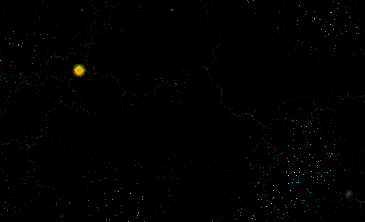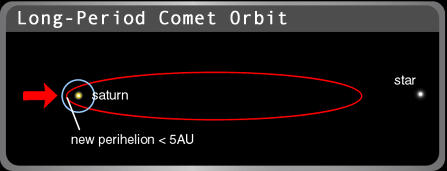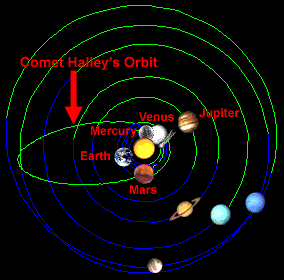 |
|
|
Part 1 Orbits: The long and short of comets |
|
Back to the Beginning... Since comets were created from the same spinning cloud of gas and dust as the planets, they continue that motion, revolving around the Sun like the planets and everything else in the solar system. Like the planets, each comet travels on a regular path, called an orbit. The planets' orbits are very nearly circular, but not quite. Each orbit has the shape of a slightly stretched-out circle, called an ellipse. Earth's orbit is so close to a circle that if you could look at it from space, you couldn't really tell the difference. But many comets revolve along more stretched-out ellipses with the Sun near one end instead of in the center. It's as if the Sun were twirling each comet on a stretchy rubber band, that gets longer and then shorter again, each time the comet comes back around the Sun. Coming and Going Having an elliptical orbit means there is a point for each comet where it is closest to the Sun. At this point we say that it is at perihelion; "peri" means close, "helio" is the root word for Sun. There is also a point where the comet is farthest away from the Sun. At this point, we say that it is at aphelion. ? In perihelion, " peri" means close. What do you think the "ap" in aphelion means? Here's one more new term: the time it takes a planet or a comet to travel once around the Sun in its orbit is called the orbital period. ? Suppose the "planet" in our definition of period is the earth. Do you know another name for the earth's orbital period? (Hint: think of the calendar.) |
|
|
Stretching the Point
In the Oort Cloud, a comet's orbit can be changed over many years by gravity, until it is long and thin, with the Sun very close to one end. These comets travel all the way from the Oort Cloud to a point inside the Kuiper Belt and back out again. If the orbit's perihelion is close enough to the Sun, say, less than 5 AU, it then receives enough solar energy to become bright and be seen by the naked eye.
Since these comets still travel from the Oort Cloud all the way around the Sun and back, they can take from hundreds of years, to over a hundred thousand (100,000) years to revolve once around the Sun. What would you call these comets? Right! They are known as long period comets. Comet Hale-Bopp, which appeared in 1997, is a long period comet. It won’t return to its perihelion near the Sun again for almost 2500 years: a long time to us, but a short time for a comet. About five out of every six comets that have been observed are long period comets. The comets that led Oort to develop his theory of the comet cloud were all long-period comets. Short and Sweet There are also comets whose entire orbit lies within the region of the Kuiper Belt, the "waistband" of comets that is just beyond the planet Neptune. These comets have periods of about 200 years or less. Because of this, they are known as short period comets. Comet Halley, which last appeared in 1986, is a short period comet.
How fast are comets? What is the latest comet's orbit? |
|
|
|
|
|
©Copyright 2000 Regents of the University of California. |

 This
picture shows a long-period comet orbit. Imagine the other Oort
Cloud comets near its aphelion. The picture is not drawn to scale.
The
actual distance to the nearest star is about twice the size of the
whole Oort Cloud.
This
picture shows a long-period comet orbit. Imagine the other Oort
Cloud comets near its aphelion. The picture is not drawn to scale.
The
actual distance to the nearest star is about twice the size of the
whole Oort Cloud. It takes 76 years for Comet Halley to complete one trip around the Sun. But as you saw, in the Origins section, many objects in the Kuiper Belt have nearly round orbits. Only a few have long flat orbits that come close to the Sun at one end. This picture shows that Halley's orbit doesn't even go beyond that of Pluto. You can just see the comet and its tail inside the orbit of Venus near perihelion. The planets are NOT drawn to scale. They are shown bigger so the viewer can recognize them.
It takes 76 years for Comet Halley to complete one trip around the Sun. But as you saw, in the Origins section, many objects in the Kuiper Belt have nearly round orbits. Only a few have long flat orbits that come close to the Sun at one end. This picture shows that Halley's orbit doesn't even go beyond that of Pluto. You can just see the comet and its tail inside the orbit of Venus near perihelion. The planets are NOT drawn to scale. They are shown bigger so the viewer can recognize them.